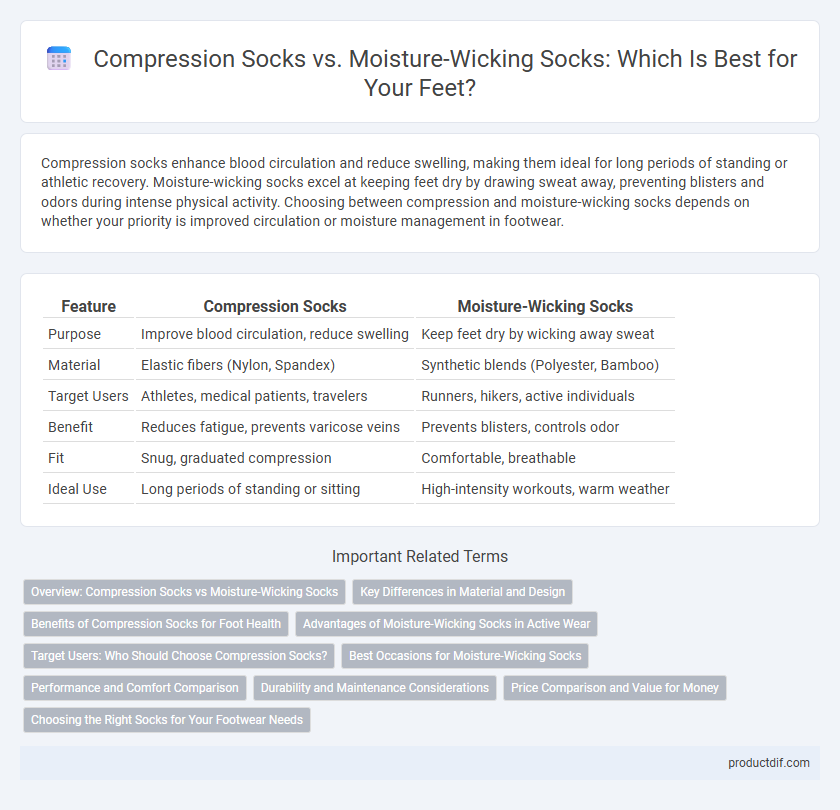Compression socks enhance blood circulation and reduce swelling, making them ideal for long periods of standing or athletic recovery. Moisture-wicking socks excel at keeping feet dry by drawing sweat away, preventing blisters and odors during intense physical activity. Choosing between compression and moisture-wicking socks depends on whether your priority is improved circulation or moisture management in footwear.
Table of Comparison
| Feature | Compression Socks | Moisture-Wicking Socks |
|---|---|---|
| Purpose | Improve blood circulation, reduce swelling | Keep feet dry by wicking away sweat |
| Material | Elastic fibers (Nylon, Spandex) | Synthetic blends (Polyester, Bamboo) |
| Target Users | Athletes, medical patients, travelers | Runners, hikers, active individuals |
| Benefit | Reduces fatigue, prevents varicose veins | Prevents blisters, controls odor |
| Fit | Snug, graduated compression | Comfortable, breathable |
| Ideal Use | Long periods of standing or sitting | High-intensity workouts, warm weather |
Overview: Compression Socks vs Moisture-Wicking Socks
Compression socks provide graduated pressure to improve blood circulation and reduce swelling, commonly used for medical or athletic recovery purposes. Moisture-wicking socks are designed with synthetic fibers like polyester or nylon to draw sweat away from the skin, enhancing comfort and preventing blisters during physical activities. Choosing between compression and moisture-wicking socks depends on whether the priority is circulation support or moisture management for foot health.
Key Differences in Material and Design
Compression socks utilize tightly woven elastic fibers such as spandex and nylon designed to apply graduated pressure for improved blood circulation and reduced swelling. Moisture-wicking socks, typically made from synthetic fibers like polyester or blends including CoolMax or merino wool, feature mesh zones and ventilation channels to enhance breathability and quickly draw sweat away from the skin. The distinct design goals reflect in compression socks' snug fit and targeted pressure zones, whereas moisture-wicking socks prioritize lightweight construction and moisture management for extended comfort during physical activity.
Benefits of Compression Socks for Foot Health
Compression socks enhance circulation, reducing swelling and preventing blood clots in the feet and lower legs, which is essential for foot health. They provide targeted support to muscles and veins, aiding in faster recovery and reducing fatigue during prolonged standing or physical activity. These socks also help manage conditions like plantar fasciitis and varicose veins by improving oxygen delivery and reducing pressure on the feet.
Advantages of Moisture-Wicking Socks in Active Wear
Moisture-wicking socks excel in active wear by efficiently drawing sweat away from the skin, keeping feet dry and reducing the risk of blisters. Their breathable fabric enhances ventilation, which helps regulate temperature during high-intensity workouts or long runs. Unlike compression socks, moisture-wicking socks prioritize moisture management and comfort, making them ideal for athletes seeking to maintain foot hygiene and minimize irritation.
Target Users: Who Should Choose Compression Socks?
Athletes, individuals with circulation issues, and those who spend long hours on their feet benefit most from compression socks by promoting blood flow and reducing swelling. Compression socks are ideal for people recovering from surgery or prone to varicose veins as they provide graduated pressure that supports vein health. Unlike moisture-wicking socks designed for sweat control during exercise, compression socks primarily target circulation and medical support needs.
Best Occasions for Moisture-Wicking Socks
Moisture-wicking socks are ideal for high-intensity activities such as running, hiking, and gym workouts where sweat management is crucial to prevent blisters and discomfort. These socks utilize synthetic fibers like polyester or nylon to efficiently pull moisture away from the skin, keeping feet dry and cool. For daily wear in hot climates or sports with rapid perspiration, moisture-wicking socks offer superior breathability and odor control compared to compression socks.
Performance and Comfort Comparison
Compression socks enhance athletic performance by improving blood circulation and reducing muscle fatigue, making them ideal for prolonged physical activities. Moisture-wicking socks excel in comfort by keeping feet dry and preventing blisters through efficient sweat management, suitable for high-intensity workouts. Both sock types offer specialized benefits, with compression prioritizing recovery and muscle support, while moisture-wicking emphasizes temperature regulation and skin health.
Durability and Maintenance Considerations
Compression socks are typically made from high-quality, tightly woven materials like nylon and spandex, offering excellent durability and resistance to wear and tear, while requiring gentle washing to maintain elasticity over time. Moisture-wicking socks often use synthetic fibers such as polyester and Coolmax, which provide effective moisture management but may experience faster fabric thinning with frequent washing and intense use. Both types demand proper care--compression socks benefit from hand washing and air drying, whereas moisture-wicking socks perform best when machine washed on gentle cycles and dried at low temperatures to extend lifespan.
Price Comparison and Value for Money
Compression socks generally come at a higher price point than moisture-wicking socks due to their specialized materials and medical-grade benefits. Moisture-wicking socks offer excellent value for money by providing affordable moisture management and breathability for everyday use. Investing in compression socks is often justified for individuals requiring improved circulation, while moisture-wicking socks suit budget-conscious customers seeking comfort during physical activities.
Choosing the Right Socks for Your Footwear Needs
Compression socks enhance blood circulation and reduce swelling, making them ideal for long periods of standing or athletic recovery. Moisture-wicking socks are designed to keep feet dry by drawing sweat away, preventing blisters and odor during intense physical activities. Selecting the right socks depends on your specific footwear needs, activity level, and foot health requirements for optimal comfort and performance.
Compression socks vs moisture-wicking socks Infographic

 productdif.com
productdif.com